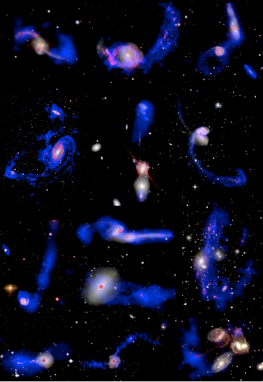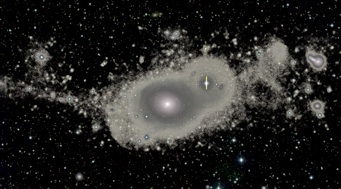
Tidal tails

Tidal tails are formed during galactic-galactic collisions through the effect of tidal forces acting mainly on the disk component of galaxies.
Tidal tails are formed whatever the mass ratio between the galaxies. However, within the MATLAS project, we will call tidal tails those formed during major mergers. They are usually gas-rich, with the mass budget being dominated by the atomic hydrogen (in blue on the figure to th left). Their stellar populations mainly consist of old stars, coming from the external regions of the parent disk, with whom they share the color. This component is diffuse, and of low surface brightness. At some locations along the tails, corresponding to local peak of the gas column density, young stars may be formed. They appear as blue compact knots. The most luminous of such condensations have the luminosity of dwarf galaxies, and are known as Tidal Dwarf Galaxies.
Optical tidal tails in a nutshell
-
• Shape: long, diffuse, may be broad
-
• Surface brightness: bellow 25 mag.arcsec-2 for old ones.
-
• Number: usually two-three around remnants of major merger
-
• Color: same color as the disks of the parent galaxies (and that of the remnant) except locally where stars have formed recently
Example of Tidal Tails candidates within the MATLAS survey

What tidal tails tell about the mass assembly of galaxies?
Given their definition, tidal tails reveal the past occurence of a major merger(1:1-1:3). The formation of tails imply the presence of disks in the parent galaxies, implying that the merger was most likely gas-rich (finding HI counterparts to the tail might help proving it). Being of low surface brightness, they are transient features, which gradually evaporate or are destroyed by subsequent mergers. Numerical simulations (see figure to the right) predict typical life time of up to 2-3 Gyr (isolated)

Number of tail tails in a simulated galaxy facing several mergers, including a major one at T=11.5 Gyr (Michel-Dansac et al., 2013)
Sample of young major wet mergers in the nearby Universe: HI distribution superimposed in blue on optical + IR (red) images © Duc